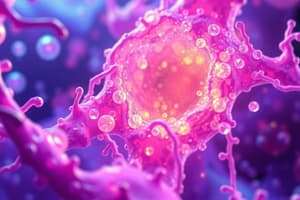Podcast
Questions and Answers
Who is credited with the invention of the microscope?
Who is credited with the invention of the microscope?
- Theodor Schwann
- Mathias Schleiden
- Antonie van Leeuwenhoek (correct)
- Anthony Levinhock
What is the main function of the ribosome in a cell?
What is the main function of the ribosome in a cell?
- To synthesize proteins (correct)
- To synthesize DNA
- To produce energy for the cell
- To regulate cell growth
What is the outer covering of a cell that separates its interior from its surrounding environment?
What is the outer covering of a cell that separates its interior from its surrounding environment?
- Plasma membrane (correct)
- Cytoplasm
- Cell wall
- Nucleus
Which of the following is NOT a component of the unified cell theory?
Which of the following is NOT a component of the unified cell theory?
What is the term for the smallest unit of a living thing?
What is the term for the smallest unit of a living thing?
What is the main difference between prokaryotic and eukaryotic cells?
What is the main difference between prokaryotic and eukaryotic cells?
Which component of the cell is responsible for enabling a prokaryotic cell to attach to surfaces in its environment?
Which component of the cell is responsible for enabling a prokaryotic cell to attach to surfaces in its environment?
What is the function of the cell wall in prokaryotic cells?
What is the function of the cell wall in prokaryotic cells?
What is the composition of the cell wall in eukaryotic cells?
What is the composition of the cell wall in eukaryotic cells?
Which component of the cell is responsible for the majority of chemical reactions occurring within the cytoplasm?
Which component of the cell is responsible for the majority of chemical reactions occurring within the cytoplasm?
Flashcards are hidden until you start studying
Study Notes
Cytology and Cell Structure
- Cytology is the science that studies cells, which are the units of composition and function in living organisms.
- The discovery of the microscope by Anthony Levinhock enabled the observation of cells and the discovery of microorganisms like bacteria and yeast.
- Cells vary in size, but are too small to be seen with the naked eye, requiring the use of a microscope to study them.
Cell Theory
- The cell theory, proposed by Botanist Mathias Schleiden and Zoologist Theodor Schwann, states that:
- All living things are composed of one or more cells.
- The cell is the basic unit of life.
- New cells arise from existing cells.
Cell Structure
- All cells share four common components:
- Cytoplasm: where cellular components are found.
- DNA: the genetic material of the cell.
- Plasma (cell) membrane: an outer covering that separates the cell's interior from its surroundings.
- Ribosome: responsible for protein synthesis.
Types of Cells
Prokaryotic Cells
- Simple cells, found in bacteria and archaea (unicellular organisms).
- Lack a nucleus and membranous organelles.
- DNA is found in the central part of the cell, called the nucleoid.
- Cell wall is made up of peptidoglycan and has a capsule made up of polysaccharide.
- Functions of the cell wall:
- Prevents dehydration.
- Provides extra layer for protection.
- Helps maintain cell shape.
- Functions of the capsule:
- Enables cell attachment to surfaces.
- Some prokaryotes have flagella for locomotion and pili for genetic material exchange during conjugation.
Eukaryotic Cells
- More complex cells, found in animals, plants, fungi, and protists.
- Have a true nucleus and membranous organelles like mitochondria, endoplasmic reticulum, Golgi, and chloroplasts.
- Have several rod-shaped chromosomes.
Cell Components
Nucleus
- Contains genetic material DNA in the form of filaments.
- Usually spherical in shape, with a large size.
- Surrounded by a nuclear envelope composed of two layers of membranes separated by 20-40nm.
- Nuclear pores form where the two layers merge.
- Functions of the nucleus:
- Contains genetic material inherited from one cell to another during division.
- Regulates cell activity.
Cytoplasm
- Located between the cell membrane and the nucleus.
- Composed of about 80% water, 15% proteins, and 5% fats, sugars, and mineral salts.
- Cytoplasm is the medium in which chemical reactions occur.
- Cytosol is the part of cytoplasm that does not contain organelles.
- Functions of cytoplasm:
- Most important cell activities occur in cytoplasm.
- Gives the cell its shape and helps maintain organelle position.
- Without cytoplasm, the cell would be deflated.
Studying That Suits You
Use AI to generate personalized quizzes and flashcards to suit your learning preferences.



